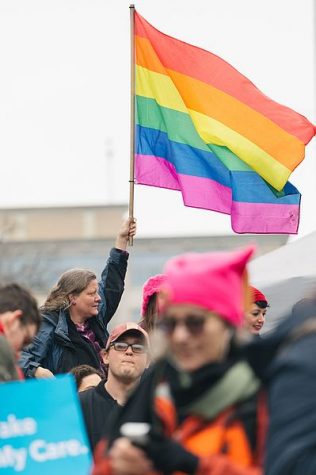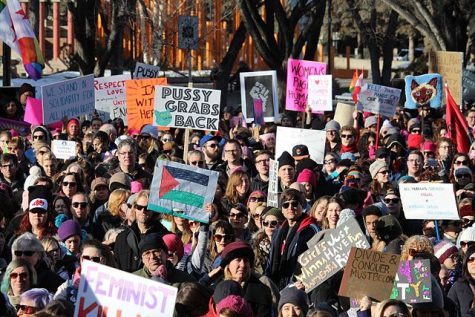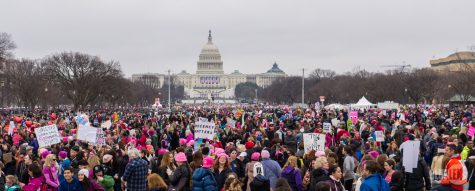Women’s March
January 28, 2017
On January 21, 2017, more than 5 million women in predominantly Washington D.C. but additionally over 500 U.S. and global cities marched in protest, which became known as the Women’s March on Washington. Following President Donald Trump’s inauguration, these protesters marched for women’s rights, LGBTQ+ rights, racial equality, freedom of religion and much more. The original demonstrations initiated and were planned in Washington, D.C., with the intent to promote women’s rights to the new presidential administration as well as the rest of the world. Hundreds of thousands of people took to the streets of Washington, D.C. chanting various slogans, including “my body, my choice” and “dump Trump.”
Said Jenny Padgett, an English teacher at Cupertino High School who flew to Washington D.C. to attend the Women’s March on Washington, “It wasn’t angry [and] it wasn’t hateful. It wasn’t even fearful. We are determined to look out…for other human beings who have been marginalized, whose voices have been silenced for any reason as long as [we] can.”
Though the march saw its biggest participants on the roads of Washington D.C., demonstrations occurred throughout various cities across the United States and the world. In the bay area, demonstrations took place on the streets of San Jose and San Francisco.


Haritha Kumar, a freshman at Cupertino and officer of the Cupertino Women’s Empowerment Association, attended a march in the Bay area. “[The Women’s March] was peaceful and I read in the news that no one got arrested, out of the entire march in [various] cities across the country…The Women’s March was spreading messages of love and tolerance. They wouldn’t stand for Trump’s bigotry [and] they wanted social justice,” she claimed.
While the march was officially nonpartisan, much of the support for the Women’s March movement and demonstrations stemmed from liberals, women and various advocacy groups, while many conservatives and groups on the right side of the political spectrum criticized it. Various minority groups supported and actively participated the march. However, some viewed it as a display of white privilege.
Said Johnetta Elzie, Ferguson protester who declined to attend any of the Women’s marches, in an interview with the Washington Post, “It’s something they almost brag about. ‘No one was arrested. The police gave us high-fives.’ The people I’ve seen saying that are white women, and that’s spoken from a complete place of privilege.”
Many critics expressed their belief that due to the large amount of white female members of the march, the likelihood of facing arrest for protesting on the streets of major cities was slim. Despite the considerate amount of minority participants, some still believed the march failed to recognize the rights of women of color.
Also in an interview with the Washington post, exclaimed Brittany Packnett, a Washington D.C. district-based activist and educator, “When we acknowledge various realities, we actually knit together a stronger movement — when we are considerate of the fact that every woman is not comfortable walking up to a police officer, given the way police have brutalized black and brown women in this country.”
On the same day following Trump’s inauguration, protests erupted in nearly all parts of the U.S. including significant cities across the world. Approximately 500,000 protestors took the streets of Los Angeles, marking the largest rally in the metropolis for at least a decade, and San Francisco saw demonstrations as well. In New York City, double the amount of expected protesters gathered in Midtown Manhattan and headed up Fifth Avenue to Trump Towers. In response to the political events in the U.S., marches initiated in London, Sydney, Cape Town and Paris as well.

Said Tamara Zafer, a current sophomore at Cupertino High School, “When our president got elected, I felt really helpless and I felt like I couldn’t do anything about what was happening. But then when they started this movement I felt like I could stand for something and I thought the movement was really beautiful.” Zafer participated in the Women’s March demonstrations in San Francisco on the 21st. “For me, it was more of a celebration of human rights and diversity [rather] than protesting against something,” she remarked.
The Women’s March evolved into the largest one-day protest and many critics and analysts consider it to be the biggest protest in U.S. history and the most globally coalesced protest. With over 2.9 million demonstrators total, the Women’s March also marked the largest inaugural protest in history.
The Women’s March also received pledged support from many celebrities and famous names of Hollywood such as Trace Ellis Ross, actress in the American sitcom Blackish, Amber Rose, American model and actress, and various artists such as Beyoncé and Madonna.
Donald J. Trump condemned the Women’s March on Washington at first and then commended the demonstrations for being rather peaceful and the protesters for utilizing their freedom of speech and expression. Initially, the morning of day after the protests, Trump announced on Twitter asking, subverting the public opposition, ““Watched protests yesterday but was under the impression that we just had an election! Why didn’t these people vote?” Yet later that morning he soothed his tone and claimed “Peaceful protests are a hallmark of our democracy. Even if I don’t always agree, I recognize the rights of people to express their views.”
Nevertheless, the women-led worldwide movement entitled the Women’s March on Washington summoned large masses of protesters to advocate for the natural rights regarding primarily gender equality, and to address the recent presidential election which many believe threatens the natural rights of women and minorities. What eventually became the largest protest in U.S. history in less than 24 hours, the number of protesters in the national and global Women’s March on Washington surpassed that of some of the greatest marches and demonstrations in U.S. history.



